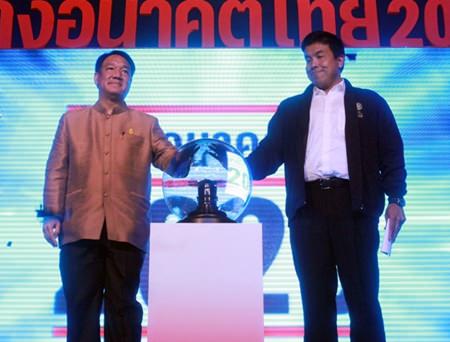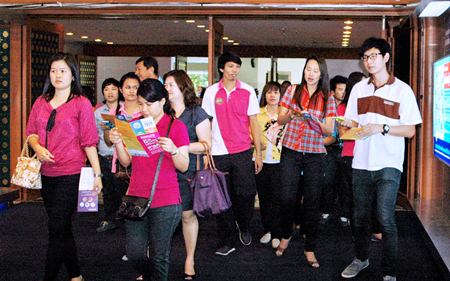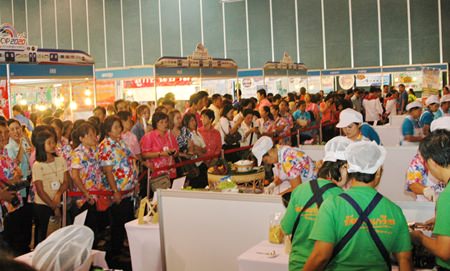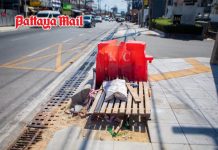Chonburi residents learned about the government’s 2.2 trillion baht infrastructure-development proposal at the “Thailand 2020 Road Show” in Pattaya.
Finance Minister Kittiratt Na Ranong and Transport Minister Chatchart Sittipan opened the lavish sales pitch for the Pheu Thai Party off-budget spending plan Oct. 15 at the Peach Convention Center in Jomtien Beach. All the area’s top political leaders also attended and organizers estimated 30,000 people attended over the three days.
Kittiratt explained the infrastructure plans while Chatchart spoke on ideas for an integrated transport system that, he claimed, will equally bring prosperity to all parts of the country. Chatchart’s speech, “Eastern Region: The Center of Industry, Investment and Tourism” focused on benefits to the Eastern Seaboard.
 Kittiratt Na Ranong, Deputy Prime Minister and Minister of Finance, and Dr. Chatchart Sittipan, Minister of Transport, co-chair the opening ceremony for the “Building the Thai Future for 2020” Road Show at the Pattaya Exhibition And Convention Hall.
Kittiratt Na Ranong, Deputy Prime Minister and Minister of Finance, and Dr. Chatchart Sittipan, Minister of Transport, co-chair the opening ceremony for the “Building the Thai Future for 2020” Road Show at the Pattaya Exhibition And Convention Hall.
“The 2 trillion baht plan is focused on developing the eastern region, since this area is considered the main money-making region for industry, tourism, agriculture and others industries,” Chatchart said. “In the past, there has been low investment, particularly in transport and transit. This is evident from the statistics of individuals travelling to the eastern region by car – about 84 percent – and by passenger buses, 16 percent. Transport is in its crisis.”
The Thailand 2020 Road Show offered multimedia information on the infrastructure projects, particularly those involving logistics. Many of these revolve around Laem Chabang Port, including high-speed trains, double-tracked freight railways and pier expansions aimed at better connecting Thailand to neighbors for the ASEAN Economic Community in 2015.
The exhibit was split into nine zones, offering justifications for the enormous spending, comparisons of transportation systems with neighboring countries, freight trucking, railroads, lifestyle changes brought about by better transport, the impact on the eastern region, high-speed passenger trains, model cities and a focus on Thailand’s south.
The spending bill remains moribund in the legislature, due mostly to objections from the Democratic Party-led opposition, which asserts that not only are Pheu Thai’s spending priorities wrong, but that the government is trying to finance its pork-barrel, vote-influencing projects illegally by excluding them from the normal budget process.
Nearly half of the money to be spent over the program’s seven years will go toward rail and mass-transit projects, while education and public health – areas where international surveys show Thailand ranks worst in Southeast Asia – get nearly nothing.
Responding to concerns about the huge expense of the spending plan – a sum equal to Thailand’s entire budget for 2013 – Kittiratt noted that Thailand has now repaid all the loans it borrowed to dig out of the 1997 financial crisis.
While the infrastructure program will take another half-century to pay off, the minister said, “When those 50 years have passed, Thailand will have countless assets that will be durable for decades.”
Chatchart agreed, saying off-budget financing is crucial to success.
“Borrowing 2 trillion baht is a project for the future and certainly will produce results within seven years,” Chatchart said. “If we did this through the normal budgeting process, development will be too slow and Thailand will have to bear heavier expenses in the future due to interest and opportunities lost.”
Conveniently, none of the debt amassed by the Yingluck Shinawatra-led government under the plan would have to be paid for another 10 years, likely well after the current government vacates office.
The National News Bureau of Thailand contributed to this report.






